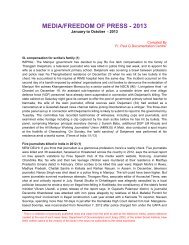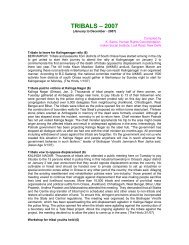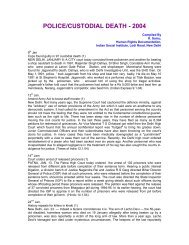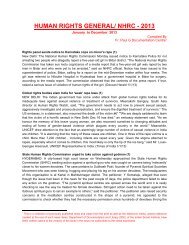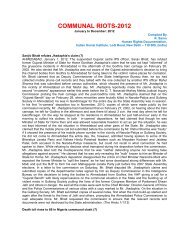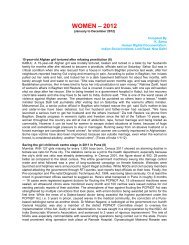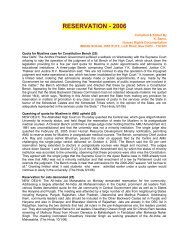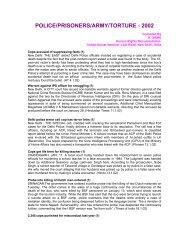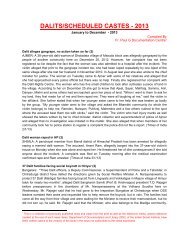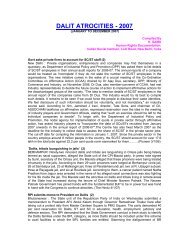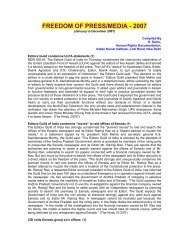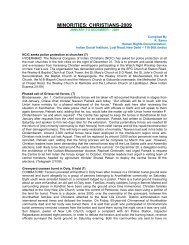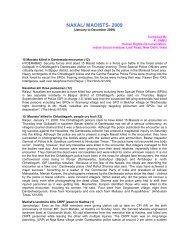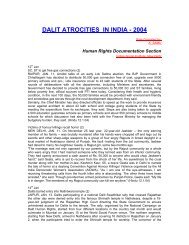Communal Violence and Inter-Community Relations - Indian Social ...
Communal Violence and Inter-Community Relations - Indian Social ...
Communal Violence and Inter-Community Relations - Indian Social ...
Create successful ePaper yourself
Turn your PDF publications into a flip-book with our unique Google optimized e-Paper software.
32<br />
SOCIAL ACTION VOL. 60 JANUARY – MARCH 2010<br />
Demonisation of Others<br />
The instances of near total violence directed against Christians in Gujarat,<br />
Karnataka <strong>and</strong> Orissa or against Muslims in various places build on the<br />
political <strong>and</strong> moral justification of distantiation. Once the distantiation is<br />
accomplished at the psychic level, expression of violence is merely a<br />
routine <strong>and</strong> a predictable pattern of behaviour directed at others. Before<br />
the desire of the dehumanisation/demonisation gets a favourable climate,<br />
the tendency to dichotomise the world into us <strong>and</strong> them is under way.<br />
As Staub (1959) says, “the ties that bind people to significant in-groups<br />
are much stronger than this: deep affective associations, shared<br />
underst<strong>and</strong>ings, common goals <strong>and</strong> the perception of a shared fate.”<br />
Consequently, enemy groups i.e. those outside of our in-groups are<br />
created <strong>and</strong> categorised by an emerging ideology, usually on the basis<br />
of cultural devaluation. Consequently, dehumanisation appears as a<br />
psychological process whereby the in-group views the other as less<br />
than human <strong>and</strong> thus not deserving moral consideration as well as<br />
political consideration. The accounts of the perpetrators <strong>and</strong> the<br />
byst<strong>and</strong>ers of the riots beginning from the Ramjanma bhoomi agitation<br />
bear testimony to the completed cycle of demonisation <strong>and</strong> this is one<br />
important reason for why it never appeared as morally outrageous to<br />
any significant populace. Protracted conflict not only strains relationships<br />
beyond repair; such conditions often lead to feelings of intense hatred<br />
<strong>and</strong> alienation among the groups. Once moral exclusion of the other is<br />
complete, the killing or the destruction has to negotiate only with the<br />
statutory <strong>and</strong> legal framework, which of course shall operate within the<br />
altered moral framework of the society. Robert Sternberg (2003) moves<br />
further <strong>and</strong> underlines that underneath the demonisation of others as<br />
prerequisite to their decimation lies the subterranean ideology of hate<br />
which is carefully nurtured <strong>and</strong> shaped in order to accomplish ends that<br />
are knowingly planned <strong>and</strong> systematically conceived. In his conceptual<br />
model, Sternberg suggests three components of hate. The first, negation<br />
of intimacy which involves the seeking of distance from a target group.<br />
This component of hate is affective; it is experienced as a negative<br />
emotion. The second component, passion, expresses itself motivationally<br />
as intense anger or fear in response to a threat. The final component,<br />
decision/commitment, is characterised by cognitions of devaluation <strong>and</strong><br />
diminution toward the target group. This is the cognitive component that<br />
is often nurtured by institutions. Dehumanisation starts at the point



